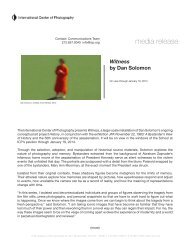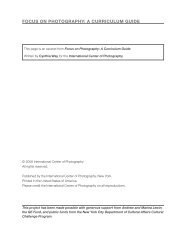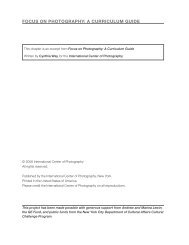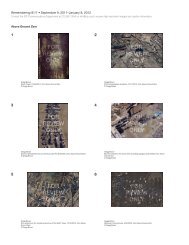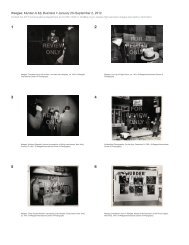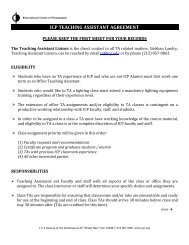Press Release PDF - International Center of Photography
Press Release PDF - International Center of Photography
Press Release PDF - International Center of Photography
Create successful ePaper yourself
Turn your PDF publications into a flip-book with our unique Google optimized e-Paper software.
Contact: Communications Department<br />
212.857.0045 info@icp.org<br />
media release<br />
Susan Meiselas:<br />
In History<br />
On view from<br />
September 19, 2008<br />
through<br />
January 4, 2009<br />
Media Preview<br />
September 18, 2008<br />
9:30—11:00 am<br />
RSVP:<br />
info@icp.org<br />
212.857.0045<br />
Susan Meiselas<br />
Photographs <strong>of</strong> 20-year-old Kamaran Abdullah Saber are held by his<br />
family at Saiwan Hill cemetery. He was killed in July 1991 during a student<br />
demonstration against Saddam Hussein, Kurdistan, Northern Iraq, 1991<br />
© Susan Meiselas/Magnum<br />
Best known for her work covering the political upheavals in Central America in the 1970s and ’80s, Susan<br />
Meiselas’s process has evolved in radical and challenging ways as she has grappled with pivotal questions<br />
about her relationship to her subjects, the use and circulation <strong>of</strong> her images in the media, and the relationship<br />
<strong>of</strong> images to history and memory. Her insistent engagement with these concerns has positioned her as a<br />
leading voice in the debate over the function and practice <strong>of</strong> contemporary documentary photography. From<br />
September 19, 2008 through January 4, 2009, the <strong>International</strong> <strong>Center</strong> <strong>of</strong> <strong>Photography</strong> (1133 Avenue <strong>of</strong> the<br />
Americas at 43rd Street) will present Susan Meiselas: In History, the first U.S. overview <strong>of</strong> the work <strong>of</strong> this<br />
major American photographer.<br />
This exhibition is structured around three key projects, presented in their complete form, which exemplify<br />
the evolution <strong>of</strong> Meiselas’s process and approach: photographs and audio <strong>of</strong> New England carnival strippers<br />
(1972-76); photographs, films, and public installations from Nicaragua (1978-2004); and photographs and<br />
collected archival objects and video from Kurdistan (1991-present).<br />
Carnival Strippers is an intimate and uncompromising depiction <strong>of</strong> the lives <strong>of</strong> a group <strong>of</strong> women working<br />
the strip tents <strong>of</strong> traveling carnivals in New England, Pennsylvania, and South Carolina. Taken at the height<br />
<strong>of</strong> the women’s movement in the United States, the photographs portray women alternately endangered<br />
by and commanding their seamy environment, and supported by a community <strong>of</strong> other women. As she<br />
photographed public performances and private moments, Meiselas made a series <strong>of</strong> audio interviews with<br />
the strippers and the men surrounding them: audience members, managers, and boyfriends. The blackand-white<br />
photographs and accompanying interviews were published in the book Carnival Strippers,<br />
which appeared in 1976 and was recently reissued. Meiselas maintains a long-term engagement with her<br />
1133 Avenue <strong>of</strong> the Americas at 43 rd Street New York NY 10036 T 212 857 0045 F 212 857 0090 www.icp.org
subjects—a hallmark <strong>of</strong> her process in future projects—and the resulting photographs <strong>of</strong>fer a resonant and complex<br />
portrait. But the work only reaches its complete form when paired with the interviews, which mediate, interpret, and<br />
counterbalance the photographs, unearthing the complexity and contradictions <strong>of</strong> the women’s feelings about their<br />
lives and what they do. The project represents an early effort to integrate the voice and intent <strong>of</strong> the documentary<br />
subject into the work. The exhibition will present vintage prints accompanied by audio interviews playing on speakers<br />
in the gallery.<br />
The second section <strong>of</strong> the exhibition will be devoted to Meiselas’s work in Nicaragua in 1978–79. Still considered<br />
by many to be her signature work, these startling color photographs <strong>of</strong> the lead-up to the overthrow <strong>of</strong> the Somoza<br />
regime and subsequent Sandinista victory were widely distributed in the international press and published in the 1981<br />
book Nicaragua. A landmark in war photography for its pioneering and controversial use <strong>of</strong> color, Meiselas’s work<br />
in Nicaragua remains a model <strong>of</strong> engaged, partisan documentary coverage. It was Meiselas’s first experience as a<br />
photojournalist, and she was forced to contend with the mixed blessing <strong>of</strong> seeing her work in wide distribution and out<br />
<strong>of</strong> her control. The desire to comment on the use and circulation <strong>of</strong> her images led to the exhibition Mediations, first<br />
presented at Camerawork in 1982. This project, which will be restaged in the ICP exhibition, presents the Nicaragua<br />
book pages alongside outtakes, tear sheets showing the images’ use in magazines, and prints sold to collectors.<br />
Mediations attempts to dismantle the meanings created and revealed by the dissemination <strong>of</strong> photographs. Three<br />
films will be shown in conjunction with the Nicaragua photographs: Voyages, a documentary from 1985 produced<br />
with Marc Karlin that presents Meiselas’s reflections on her relationship to the history she witnessed; Pictures from a<br />
Revolution, Meiselas’s 1991 film following her search for the people featured in the photographs twenty years earlier;<br />
and Re-framing History, which traces her return to Nicaragua in 2004 for the 25th anniversary <strong>of</strong> the revolution to<br />
install mural-sized images <strong>of</strong> her photographs in the sites where they were originally taken.<br />
The final section <strong>of</strong> the exhibition will present Meiselas’s work with Kurdish communities in Turkey, Iran, and Iraq.<br />
In 1991, after more than a decade <strong>of</strong> work in Latin America, Meiselas obtained access to the “liberated” zone in<br />
northern Iraq, and later accompanied a forensic anthropologist to document the mass graves <strong>of</strong> Kurds killed in<br />
Saddam Hussein’s “Anfal” campaign three years earlier. Her interest in understanding the cultural identity <strong>of</strong> the<br />
Kurds led to a six-year foray into the photographic history <strong>of</strong> the region. Meiselas gathered family photographs,<br />
portraits, documents, and stories that interweave with her own photos to create “a sourcebook <strong>of</strong> suppressed<br />
history.” Kurdistan: In the Shadow <strong>of</strong> History was published in 1997, and an associated website called akaKurdistan<br />
allows viewers to add their own images and stories, creating a virtual national archive for a stateless people. An<br />
exhibition <strong>of</strong> the material toured internationally, but has never been shown in New York, and has appeared at only<br />
two venues in the United States. In its massive scope and meticulous detail, Kurdistan is a major statement about the<br />
relationships between photography, memory, archives, and history. It also represents an important shift in Meiselas’s<br />
practice toward collecting and curating found images, presaging the rising cultural interest in vernacular photography<br />
and archives. Since 2007 she has returned to northern Iraq numerous times to document the radical transformations<br />
in the region brought upon by the Iraq war. Coupled with archival material and her own photographs from 1991-92,<br />
this new photographic work will be seen for the first time in the ICP exhibition.<br />
Background<br />
Meiselas received her M.A. in visual education from Harvard University, and at the age <strong>of</strong> 24, taught photography<br />
workshops for teachers and children in New York’s South Bronx. During her summers, she traveled to New England<br />
to photograph and interview women who worked as strippers in itinerant carnivals. On the basis <strong>of</strong> that work,<br />
Meiselas was invited to join the Magnum Photos cooperative, <strong>of</strong> which she remains a member.<br />
Meiselas’s coverage <strong>of</strong> hostilities in Central America during the 1970s and ‘80s was widely published throughout the<br />
world. She was presented the Robert Capa Gold Medal for “outstanding courage and reporting” by the Overseas<br />
<strong>Press</strong> Club in 1979 for her work in Nicaragua. She served as an editor and contributor to the books El Salvador: The<br />
Work <strong>of</strong> Thirty Photographers (1983) and Chile from Within (1991). Meiselas has also co-directed two films based on<br />
her involvement in Nicaragua, Living at Risk: The Story <strong>of</strong> a Nicaraguan Family (1985), and Pictures from a Revolution<br />
(1991).<br />
In 1997, she completed a six-year project on the 100-year photographic history <strong>of</strong> Kurdistan. Kurdistan: In the<br />
Shadow <strong>of</strong> History, an exhibition, book, and website, earned her a MacArthur Fellowship. Like the recent ICP/Steidl<br />
book Encounters with the Dani, which pieces together a richly layered visual history <strong>of</strong> an indigenous people through<br />
the eyes <strong>of</strong> outsiders, Kurdistan examines the relationship between power and representation. Meiselas’s own
photographs play a supporting role in both projects, with painstakingly gathered archival images and documents<br />
carrying the weight <strong>of</strong> the story.<br />
The complicated trajectory <strong>of</strong> Meiselas’s work has <strong>of</strong>ten been reduced to a simplified narrative: a war photographer<br />
who rejects traditional photojournalism and puts down her camera in favor <strong>of</strong> mining found imagery and promoting<br />
the work <strong>of</strong> other photographers. A closer examination <strong>of</strong> her career shows that, from her earliest activity to her<br />
most recent, Meiselas has consistently interrogated and expanded the documentary tradition, fueling cross-genre<br />
dialogue with anthropologists, human rights workers, and critical theorists to work toward a new understanding <strong>of</strong><br />
the role <strong>of</strong> photographs in understanding histories and communities.<br />
The exhibition is organized by Kristen Lubben, Associate Curator at the <strong>International</strong> <strong>Center</strong> <strong>of</strong> <strong>Photography</strong>.<br />
Publications<br />
Susan Meiselas: In History will be accompanied by a catalogue, published by ICP/Steidl, which will be the first<br />
compendium <strong>of</strong> Meiselas’s work. Containing both celebrated and unpublished bodies <strong>of</strong> images, it will also feature<br />
texts by Kristen Lubben, Abigail Solomon-Godeau, David Levi Strauss, Lucy Lippard, Edmundo Desnoes, Diana<br />
Taylor, Elizabeth Edwards, Caroline Brothers, and Allan Sekula.<br />
In addition, reprints <strong>of</strong> both Nicaragua (Aperture and <strong>International</strong> <strong>Center</strong> <strong>of</strong> <strong>Photography</strong>, 2008) and Kurdistan: In the<br />
Shadow <strong>of</strong> History (University <strong>of</strong> Chicago <strong>Press</strong>, 2008) are now available.<br />
Sponsor<br />
This exhibition is made possible by Shell



